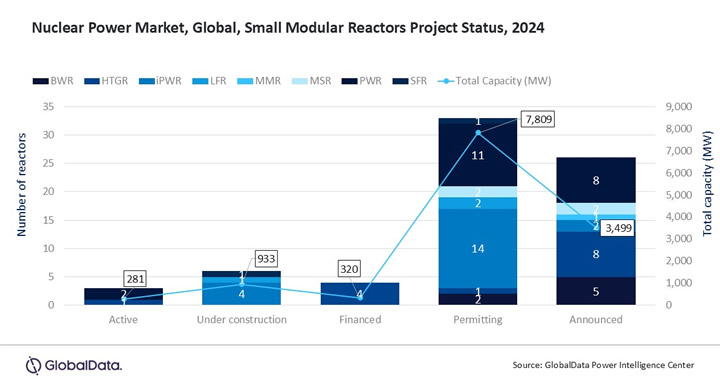Global nuclear power capacity to reach 494GW by 2035, driven by advancements in SMRs and clean energy shift, says GlobalData
The global nuclear power sector has witnessed steady growth in recent years, driven by the need for low-carbon baseload power, energy security, and a renewed interest in decarbonizing industrial sectors. New capacity additions, advancements in reactor technology with small modular reactors (SMRs) emerging as a transformative solution, and supportive policies have contributed to increased generation and reinforced the role of nuclear power in the energy transition. Against this backdrop, nuclear capacity is forecast to grow from 395GW in 2024 to 494GW by 2035, according to GlobalData, a leading data and analytics company.
GlobalData’s latest report, “Nuclear Power Market, Update 2025 – Market Size, Segmentation, Major Trends, and Key Country Analysis to 2035,” reveals that nuclear electricity generation will rise from 2,616 TWh to 3,410 TWh over 2024-35, reflecting a CAGR of 2%. While nuclear power accounted for around 9% of global electricity generation, countries with aging reactors have pursued lifetime extensions, while others have aggressively expanded their nuclear fleets, especially in Asia.
The US remains the world’s largest producer of nuclear power, with 97GW of installed capacity generating 787.6 TWh in 2024. France, which relies on nuclear for over 60% of its electricity, follows with 61.4GW and 333.3 TWh of annual generation. China, with the youngest and fastest-growing nuclear fleet, has expanded its capacity to 56GW, producing 386.1 TWh, surpassing France in total nuclear electricity generation.

Mohammed Ziauddin, Power Analyst at GlobalData, comments “The growing focus on energy security due to geopolitical tensions, increasing demand for low-carbon dispatchable power, government support through regulations and incentives such as grants, loan guarantees, production and investment tax credits (PTCs and ITCs), and market-based mechanisms like Contracts for Difference (CfDs), advancements in SMRs and next-gen technologies, and a surge in electricity demand from data centers are the major reasons behind the increasing adoption of nuclear energy worldwide.”
Unlike traditional large-scale nuclear reactors, SMRs offer compact designs, flexible deployment, and advanced safety features that make them well-suited for remote regions, smaller grids, and industrial applications. With capacities typically under 300MW, SMRs can be factory-fabricated, transported, and assembled on-site, significantly reducing construction time and costs.
The global SMR pipeline is expanding rapidly, with over 100 reactors at various stages of development. Although only a few SMRs are currently operational, primarily in Russia and China, the next decade is expected to bring a significant increase in new capacity, with more than 10,000MW anticipated by 2035. Countries such as the US, Canada, the UK, China, and Russia are leading the charge with diverse deployment strategies, marking SMRs as a key pillar in the global transition toward secure, low-carbon energy systems.

Zia concludes: “With growing concerns over climate change and energy security, nuclear power has re-emerged as a crucial pillar in the global energy transition. Governments across the world are implementing ambitious net-zero targets and investing in clean, dispatchable energy sources to decarbonize their economies. Nuclear energy, with its ability to provide reliable baseload power and reduce dependency on fossil fuels, is playing a vital role in this transition.
“As countries ramp up their focus on SMRs, lifetime extensions, and advanced nuclear technologies, the nuclear power market is poised for long-term growth, driven by the dual goals of energy resilience and climate neutrality.”
- Quotes provided by Mohammed Ziauddin, Power Analyst at GlobalData
- Information based on GlobalData’s report “Nuclear Power Market, Update 2025 – Market Size, Segmentation, Major Trends, and Key Country Analysis to 2035,” which provides nuclear power market study at the global level, and at a key country level covering ten key countries in depth
Comments (0)
This post does not have any comments. Be the first to leave a comment below.
Featured Product

